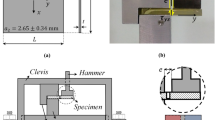Abstract
The four-point bend test is one of the simplest and often the preferred flexural strength evaluation method for brittle materials. In this loading mode, fracture often initiates from a critical surface (or subsurface) flaw when subjected to a tensile stress state. However, if the critical flaw exists on the compression side of the test specimen, it may not activate to grow a crack and hence the resulting flexural strength will be higher than the true value. The goal of this study is to measure the true flexural strength of a solid or hollow cylindrical brittle specimen by ensuring that failure occurs at its weakest point by rotating along its longitudinal axis, thereby exposing and activating its critical surface flaw during a four-point bend test. A novel test fixture has been designed and fabricated, and the true flexural strengths of cylindrical brittle and quasi-brittle tubular specimens have been measured and compared to existing experimental data obtained through traditional four-point bend tests. Experimental results showcase the orientation dependance on flexural strength for various materials. Additionally, similarities between experimental findings and those available in literature, including observations of fracture surfaces and relationships between surface roughness and material strength, are discussed.







Similar content being viewed by others
Notes
Lower grit numbers refer to coarser and larger grits and hence, result in higher surface roughness on the specimens.
References
Oses C, Toher C, Curtarolo S (2020) High-entropy ceramics. Nat Rev Mater 5:295–309. https://doi.org/10.1038/s41578-019-0170-8
Subhash G, Ghosh D, Awasthi A (2021) Dynamic response of advanced ceramics. Wiley, Hoboken
Bavdekar S, Subhash G (2021) Failure mechanisms of ceramics under quasi-static and dynamic loads: overview. Handbook of damage mechanics. Springer New York, New York, pp 1–29
Griffith AA (1921) The phenomena of rupture and flow in solids. Philos Trans R Soc A Math Phys Eng Sci 221:163–198. https://doi.org/10.1098/rsta.1921.0006
Vargas-Gonzalez L, Speyer RF, Campbell J (2010) Flexural strength, fracture toughness, and hardness of silicon carbide and boron carbide armor ceramics. Int J Appl Ceram Technol 7:643–651. https://doi.org/10.1111/j.1744-7402.2010.02501.x
ASTM (2018) ASTM C1421-18, Standard test methods for determination of fracture toughness of advanced ceramics at ambient temperature. ASTM International, West Conshohocken
Nie X, Chen WW, Wereszczak AA, Templeton DW (2009) Effect of loading rate and surface conditions on the flexural strength of borosilicate glass. J Am Ceram Soc 92:1287–1295. https://doi.org/10.1111/j.1551-2916.2009.03019.x
Cantrell JT, Rohde S, Damiani D et al (2017) Experimental characterization of the mechanical properties of 3D-printed ABS and polycarbonate parts. Rapid Prototyp J 23:811–824. https://doi.org/10.1108/RPJ-03-2016-0042
Spierings GACM (1993) Wet chemical etching of silicate glasses in hydrofluoric acid based solutions. J Mater Sci 28:6261–6273. https://doi.org/10.1007/BF01352182
Bouras N, Madjoubi MA, Kolli M et al (2009) Thermal and mechanical characterization of borosilicate glass. Phys Procedia 2:1135–1140. https://doi.org/10.1016/j.phpro.2009.11.074
Quinn GD (2016) NIST Recommended practice guide fractography of ceramics and glasses. Gaithersburg, MD
Tsirk A (2014) Fractures in knapping. Archaeopress Publishing Ltd, Gloucestershire
Horii H, Nemat-Nasser S (1985) Compression-induced microcrack growth in brittle solids: Axial splitting and shear failure. J Geophys Res 90:3105. https://doi.org/10.1029/jb090ib04p03105
Ashby MF, Hallam (Née Cooksley) SD (1986) The failure of brittle solids containing small cracks under compressive stress states. Acta Metall 34:497–510. https://doi.org/10.1016/0001-6160(86)90086-6
Wallner H (1939) Linienstrukturen an Bruchflächen. Z Phys 114:368–378. https://doi.org/10.1007/BF01337002
Buckley-lewis DH (1973) Friction behavior of glass and metals in contact with glass in various environments. Nasa Technical Note
Zortrax SA (2020) Z-HIPS Technical Data. zortrax.com/filaments/z-hips/. Accessed 6 Oct 2021
Zortrax SA (2020) Z-UltraT Technical Data. zortrax.com/filaments/z-ultrat/. Accessed 6 Oct 2021
Ahn S, Montero M, Odell D et al (2002) Anisotropic material properties of fused deposition modeling ABS. Rapid Prototyp J 8:248–257. https://doi.org/10.1108/13552540210441166
Bellini A, Güçeri S (2003) Mechanical characterization of parts fabricated using fused deposition modeling. Rapid Prototyp J 9:252–264. https://doi.org/10.1108/13552540310489631
ASTM (2014) Standard test method for tensile properties of plastics. ASTM International, West Conshohocken
Syrlybayev D, Zharylkassyn B, Seisekulova A et al (2021) Optimisation of strength properties of FDM printed parts—A critical review. Polym (Basel) 13. https://doi.org/10.3390/polym13101587
Engineering ToolBox (2008) Ceramic materials properties. https://www.engineeringtoolbox.com/ceramics-properties-d_1227.html
Alarcon OE, Medrano RE, Gillis PP (1994) Fracture of glass in tensile and bending tests. 25:961–968. https://doi.org/10.1007/BF02652271
Acknowledgements
The research was performed under Department of Energy (DOE) Nuclear Energy University Programs (NEUP) grant number DE-NE0008773 to University of Florida.
Author information
Authors and Affiliations
Corresponding author
Ethics declarations
The authors declare that they have no known competing financial interests or personal relationships that could have appeared to influence the work reported in this paper.
Additional information
Publisher’s Note
Springer Nature remains neutral with regard to jurisdictional claims in published maps and institutional affiliations.
Rights and permissions
About this article
Cite this article
MacIsaac, M., Bavdekar, S., Nance, J. et al. A Novel Rotating Flexure-Test Technique for Brittle Materials with Circular Geometries. Exp Tech 47, 505–516 (2023). https://doi.org/10.1007/s40799-022-00565-6
Received:
Accepted:
Published:
Issue Date:
DOI: https://doi.org/10.1007/s40799-022-00565-6




